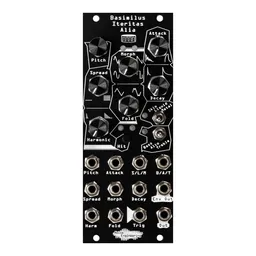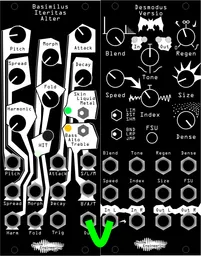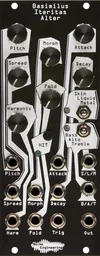Recently, we were giving a demo of Mimetic Digitalis to a friend. I showed off one of my favorite techniques: using it as a sort of “preset manager” with something like the BIA. After some jamming, we realized this should be a blog post. Read on to learn more about this fun technique…
All of this is a little unconventional
Mimetic Digitalis is a sequencer. However, that’s not really how we’re going to be using it here. Generally, you send a sequencer a clock, maybe a reset signal, patch it to your oscillator’s pitch input and you’re off. We won’t be doing that. Like, at all. Have no fear: thinking outside the box is always fun, and this is, in my opinion, a fun and immediate technique once you get the hang of it (even if it admittedly requires a little planning…).
The first weird concept: sequencing your sequencer
MD has a LOT of inputs. 8, to be exact. 5 of these are trigger ins, and the other 3 are CV inputs. Those CV inputs are what we’ll be making use of here.
This whole technique requires some support hardware (my fancy phrase for “a buncha other modules”). The N CV input on MD allows you to address every step on MD with control voltage, meaning you can sequence the steps in whatever weird order you want. So I could have a 4 step sequence, but MD is going from step 1 to 7 to 3 to 11. Funky! I usually pair it with another one of my sequencers like the NerdSeq or the Stillson Hammer MKII, or, if I want to keep it small and simple, the Vox Digitalis. With this technique, I sacrifice one cv output from the sequencer I’m using to control the MD, but I gain four CV outputs by using the MD, so it’s a reasonable trade-off.
I can then create a sequence on that “control” sequencer that moves MD around. You’re probably starting to see where I’m going with this…
Learn more:
The second weird part: the presets
The next step is to actually create our “presets”. This whole technique can work with virtually anything, but let’s start with the BIA, like we talked about initially. Depending on the kind of sounds you want to patch, you’ll want to choose different CV inputs, but I generally use Attack, Decay, S/L/M, and Morph. (Side note: This is assuming you’re using another sequencer for pitch and triggering the BIA. Remember how I said this would require a lot of support hardware?) The next step is to create our “presets”. With those four parameters under CV, we can easily make a lot of different drum and synth sounds. I usually start with a kick. Navigate the MD to the first step, and start programming. You’ll want Attack to be around the middle, Decay relatively short, S/L/M to be on Liquid, and Morph at minimum. Easy! Next, a snare: set MD to the next step, program Attack and Decay to minimum, S/L/M to Skin mode, Morph still at minimum. Keep going with some hats, toms, whatever. And, since we have a whopping 16 steps, you can easily create slight variations of all these “presets” too to keep your sequences interesting (how many kick variations do you want? You can make them ALL). Even better, you can save patterns in one of MD’s 16 save slots to keep “banks” of presets. [Note: want to see a whole bunch of cool sounds you can make with Basimilus Iteritas Alter, including the ones above, in a beautiful illustrated PDF? Check out the BIA Patchbook!
Making some sound
Now that we have our presets together, it’s time to make some noise. Here, we programmed a bunch of drum sounds into the MD and sequenced them with Vox Digitalis. We then use Shred and Undo on MD to make new sounds on the fly.
This isn’t just for drums th
I actually started using this technique at first for chords. Each step on MD would be a different four-note chord, which made it super easy to create big polyphonic-sounding patches pretty easily (check the embedded IG clip!). There are tons and tons of different ways to use this sort of technique, so again, think outside the box! I guarantee you’ll think of another way to use it in your system.
This isn’t just an MD thing
There are actually lots of sequencers that you can do this sort of thing with. The NerdSeq has “Patches”, which allow you to, among other things, assign all 12 CV outputs to recallable values on each step, which I use all the time for this sort of thing. Going the other direction, you could do something like this with Pressure Points.
Going completely overboard
Thinking about MD again, though: if you have multiple MD’s, you can control way more parameters, but control all the MD’s with one control signal from your control sequencer. Speaking of…
Going completely overboard, IRL!
Here, we’re using two MD’s to sequence “presets” on Loquelic Iteritas Percido. We’re clocking/triggering everything with Horologic Solum, and controlling the MD’s with Vox Digitalis. Lapsus Os is also patched up to the X inputs on the two MD’s to add a little bit of variation.






